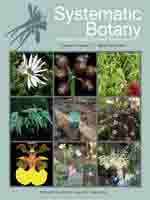The application of genetic tools for studying species delimitation and relationships in Sphagnum (peatmosses) has demonstrated that evolutionary patterns are complex and include homoploid hybridization and multiple taxa of allopolyploid origin. We investigated evolutionary relationships in the so-called S. fimbriatum complex and tested hypotheses of species delimitation derived from patterns of morphological variation, and determined the origin of one species with diploid gametophytes. Plastid DNA sequences resolve a single haplotype shared by one described species, S. concinnum, and a morphotype that we had hypothesized to be another species (referred to informally as S. “diskoense”). All samples of the polyploid, S. tescorum, share an identical haplotype with most samples of S. girgensohnii. Sphagnum fimbriatum and S. girgensohnii share several plastid DNA haplotypes, and also share haplotypes with two other morphotypes that we had hypothesized to be distinct species (S. “obscurum” and S. “ubertum”). Fixed or nearly fixed heterozygosity at ten microsatellite loci show that S. tescorum is an allopolyploid. Genetic admixture analyses and computation of hybrid indices from microsatellite data, in combination with sequences from the plastid genome, support the hypothesis that S. fimbriatum and S. girgensohnii are progenitors of S. tescorum, with S. girgensohnii as the maternal parent. Data from 14 microsatellite loci demonstrate that S. concinnum, S. fimbriatum, S. girgensohnii, and S. tescorum are genetically distinct but the same data do not support separation of S. “diskoense,” S. “obscurum,” and S. “ubertum.” Homoploid hybridization between S. fimbriatum and S. girgensohnii is strongly suggested by genetic data and phylogenetic analyses.
How to translate text using browser tools
1 January 2012
Systematics of the Sphagnum fimbriatum Complex: Phylogenetic Relationships, Morphological Variation, and Allopolyploidy
A. Jonathan Shaw,
Kjell Ivar Flatberg,
Peter Szövényi,
Mariana Ricca,
Matthew G. Johnson,
Hans K. Stenøien,
Blanka Shaw
ACCESS THE FULL ARTICLE

Systematic Botany
Vol. 37 • No. 1
January 2012
Vol. 37 • No. 1
January 2012
Admixture analysis
allopolyploidy
hybridization
microsatellites
Sphagnum
Sphagnum fimbriatum
trnG




